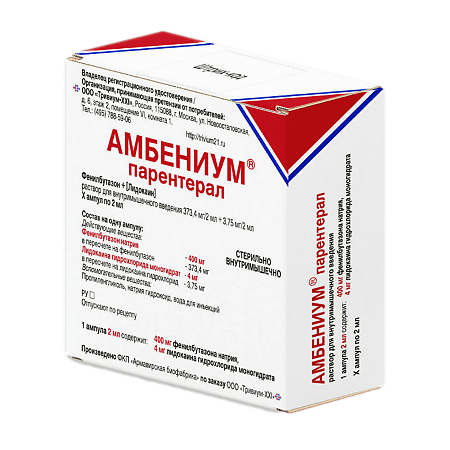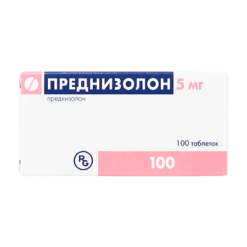No products in the cart.
Ambenium, 373.4 mg/2ml+3.75 mg/2ml 2 ml 3 pcs
€54.71 €45.59
Description
Pharmacodynamics
Phenylbutazone has anti-inflammatory, analgesic, antipyretic effects. It indiscriminately inhibits the activity of cyclooxygenases (COX-1 and COX-2), disrupts the metabolism of arachidonic acid, reduces the number of prostaglandins in the inflammation focus. Prostaglandins play an essential role in the development of the inflammatory reaction. Anti-inflammatory and analgesic effect of phenylbutazone reduces the severity of pain and inflammatory edema, morning stiffness, joint swelling, contributes to increased range of motion. Uricosuric effect of phenylbutazone is associated with reduction of tubular resorption of uric acid in the kidneys.
Lidocaine hydrochloride has a local anesthetic effect, blocks potential-dependent sodium channels, which prevents the generation of impulses in the endings of sensitive nerves and conduct of impulses along the nerve fibers. Suppresses the conduction of not only pain impulses, but also impulses of other modality. Reduces the pain effect during injection.
Pharmacokinetics
Phenylbutazone
Assimilation. After intramuscular injection of the drug, phenylbutazone is rapidly released within 2 hours. Then for several hours the concentration of phenylbutazone in the systemic bloodstream is maintained at a high level of 80-90% of the maximum.
Metabolism. The metabolism of phenylbutazone occurs by oxidation and glucuronidation in the liver. The main metabolite is pharmacologically active oxyphenbutazone. Other metabolites have less anti-inflammatory activity.
Elimation. Elimination of unchanged active substance as well as its metabolites occurs both via the kidneys (about 70%) and in the bile through the intestine (about 30%). The elimination half-life is 50 to 100 hours and may increase significantly with impaired hepatic and renal function.
Binding to blood plasma proteins is 99 %, which is significant with possible drug interactions of phenylbutazone.
Lidocaine hydrochloride
Intake. Systemic absorption of lidocaine is determined by the site of administration, the dose and its pharmacological profile. The main factor determining the rate of absorption and blood concentration is the total dose administered, regardless of the site of administration. There is a linear relationship between the amount of lidocaine administered and the resulting maximum blood concentration of the anesthetic.
Distribution. Lidocaine binds to plasma proteins, including a1-acid glycoprotein (AKG) and albumin. The degree of binding is variable, being approximately 66%. Lidocaine penetrates the blood-brain and placental barriers.
Metabolism. Lidocaine is metabolized in the liver, about 90% of the administered dose undergoes N-dealkylation to form monoethylglycincylidide (MEGX) and glycincylidide (GX).
Evacuation. The terminal elimination half-life of lidocaine after intravenous bolus administration in healthy adult volunteers is 1-2 hours.
Indications
Indications
Symptomatic treatment of pain and inflammation in acute exacerbations:
– ankylosing spondylitis (Bechterew’s disease);
– rheumatoid arthritis;
– gout.
The drug is intended for symptomatic therapy, to reduce pain and inflammation at the time of use; it has no effect on the progression of the disease.
The use of Ambenium® Parenteral should generally only be made if other therapeutic measures, including other non-steroidal anti-inflammatory drugs, have not had a sufficient analgesic effect.
The use of phenylbutazone at a dose higher than recommended (373.4 mg) or additional use of other NSAIDs (the exception is acetylsalicylic acid in doses not exceeding 325 mg, used as an antiaggregant) does not provide additional analgesic effect, but significantly increases the risk of adverse events and therefore is not recommended.
Active ingredient
Active ingredient
Composition
Composition
Active substances:
Phenylbutazone sodium – 400 mg
Translated into phenylbutazone – 373.4 mg
Lidocaine hydrochloride monohydrate – 4 mg
recalculated to lidocaine hydrochloride – 3.75 mg
Auxiliary substances:
Propylene glycol, sodium hydroxide, water for injection
How to take, the dosage
How to take, the dosage
In order to reduce the risk of gastrointestinal adverse events, the lowest effective dose should be used for the shortest possible course.
To treat acute conditions or to relieve an exacerbation of a chronic condition, the drug is given single deep into the muscle slowly at a dose of 373.4 mg (2 ml)
This dosage form should be used once. Further treatment should be given with phenylbutazone in tablet form, if necessary, and all relevant directions for use should be followed.
Because of the possible occurrence of anaphylactic reactions up to and including anaphylactic shock when using the drug, a functional emergency care kit must be ensured within reach. After administering the drug the patient should be observed for at least 1 hour. The patient should be made aware of the importance of this measure.
Interaction
Interaction
The concomitant use of phenylbutazone and glucocorticosteroids or nonsteroidal anti-inflammatory drugs and analgesics increases the risk of gastrointestinal side effects.
The simultaneous use of barbiturates (e.g., phenobarbital), chlorphenamine, rifampicin, promethacin, and colestyramine decreases the serum concentration of phenylbutazone and therefore decreases the analgesic effect.
The concomitant use of methylphenidate or anabolic steroids (methandrostenolone) may increase the serum concentration of phenylbutazone and thereby increase the effect.
The concomitant use of phenylbutazone and phenytoin or lithium may increase plasma levels of these medications, which requires monitoring their blood concentrations.
The concomitant use of phenylbutazone and potassium-saving diuretics may increase plasma potassium levels, which requires monitoring of blood potassium concentrations.
Phenylbutazone may weaken the effects of digoxin, cortisone, diuretics, and hypotensive drugs.
Phenylbutazone administration within 24 hours before or after methotrexate administration may lead to increased plasma concentrations of methotrexate and potentiate its adverse reactions.
The concomitant use of phenylbutazone and anticoagulants (e.g., coumarin preparations, sulfonamides) may lead to increased thrombolytic effects.
Phenylbutazone may increase the effect of tablet hypoglycemic agents, thus there is a risk of hypoglycemia.
Special Instructions
Special Instructions
Because of the important role of prostaglandins in maintaining renal blood flow, special caution should be exercised when prescribing in patients with heart failure, as well as in therapy in elderly patients taking diuretics and in patients who for any reason have reduced circulating blood volume (including after major surgery). If phenylbutazone is prescribed in these cases, it is recommended to monitor renal function as a precautionary measure.
If an increase in “hepatic” transaminases is seen after use, or if clinical symptoms of hepatotoxicity (including nausea, fatigue, somnolence, diarrhea, pruritus, jaundice) are noted, treatment should not be repeated at a later time.
Phenylbutazone (like other nonsteroidal anti-inflammatory drugs) may cause hyperkalemia.
Long-term therapy with phenylbutazone should include monitoring of liver function, peripheral blood count, fecal occult blood test.
Due to its negative effect on fertility, the drug is not recommended for women who want to become pregnant. In patients with infertility (including those undergoing examination) it is recommended to discontinue the drug.
Phenylbutazone makes it difficult to interpret laboratory tests to assess thyroid function by changing their values.
There is a significant risk of anaphylactic reactions, including anaphylactic shock. If dizziness, vomiting, confusion, abnormal heart rhythm, bradycardia, arterial hypotension occur immediately after injection, emergency medical assistance is required.
Influence on ability to drive vehicles and mechanisms
At the time of treatment, mental and motor reactions may decrease, so one should refrain from driving and engaging in other potentially dangerous activities requiring increased concentration and rapid psychomotor reactions.
Synopsis
Synopsis
Contraindications
Contraindications
– hypersensitivity to phenylbutazone, lidocaine, amide type anesthetics or excipients of the drug;
– severe cardiac conduction disorders, acute myocardial infarction in the period after coronary artery bypass grafting;
– decompensated heart failure;
– complete or incomplete combination of bronchial asthma, recurrent nasal and paranasal sinus polinosis and intolerance to acetylsalicylic acid or other NSAIDs (including a history);
– diseases of the blood and coagulation system (leukopenia, including a history, thrombocytopenia, hemophilia);
– active erosive-ulcerative lesions of the stomach or duodenum, or ulcerative disease of the stomach and duodenum, ulcerative colitis, Crohn’s disease;
– gastrointestinal bleeding, including.Ñ. in anamnesis, triggered by taking NSAIDs;
– intracranial bleeding, acute cerebral circulation disorders;
– renal or hepatic impairment;
– confirmed hyperkalemia;
– pregnancy, breastfeeding, children (under 18).
Cautions
Hepatic diseases in the history, hepatic porphyria, chronic heart failure, arterial hypertension, significant reduction in circulating blood volume (including after surgical intervention), elderly patients (including those receiving diuretics, weakened and disabled). diuretics, weakened patients and patients with low body weight), bronchial asthma, concomitant use of glucocorticosteroids (including prednisolone), anticoagulants (including warfarin), antiplatelet agents (including acetylsalicylic acid, clopidogrel), selective serotonin reuptake inhibitors (including citalopram), and selective serotonin reuptake inhibitors (including citalopram).including citalopram, fluoxetine, paroxetine, sertraline), coronary heart disease, cerebrovascular disease, dyslipidemia/hyperlipidemia, diabetes, peripheral arterial disease, smoking, Helicobacter pylori infection, long-term use of NSAIDs, thyroid disease, tuberculosis, alcoholism, severe medical conditions. Concomitant use with other NSAIDs, including COX 2 selective, should be avoided.
Side effects
Side effects
Frequently, 1-10%; infrequently, 0.1-1%; rarely, 0.01-0.1%; very rarely, less than 0.001%, including isolated cases.
Digestive system: Frequently – nausea, diarrhea and gastrointestinal bleeding, which in some cases may cause anemia. Infrequent – increased transaminase activity, cholestatic syndrome, hepatitis. Rarely – gastric and duodenal ulcer, gastrointestinal bleeding (usually accompanied by severe upper abdominal pain and/or staining of feces black), functional disorders of the pancreas.
On the side of the nervous system: Infrequent – Headache, agitation, irritability, insomnia, dizziness and fatigue; Very rare – may have local reactions: Peripheral neuritis of the sciatic nerve.
In the urinary system: Infrequent – generalized and/or peripheral edema; Very rare – decreased amount of urine excreted, edema unresponsive to therapy with diuretics, acute renal failure.
Hematopoietic organs: Rarely – anemia, leukopenia, thrombocytopenia, pancytopenia, agranolocytosis.
Allergic reactions: Frequently: – hypersensitivity reactions; Very rare – Swelling of the face, tongue and larynx. Swelling, shortness of breath, palpitations, anaphylactic shock.
Cardiovascular system side: Rarely – decrease or increase in blood pressure; Very rare – acute circulatory disorders.
Injuries to the respiratory system: Rarely – bronchial asthma, pulmonary edema.
Side of the skin and subcutaneous fat: Frequently – skin rash and itching; Very rare – fat tissue necrosis when injected improperly into fat tissue; Very rare – Stevens-Johnson syndrome, Lyell’s syndrome, discoid lupus erythematosus.
Unwanted reactions to lidocaine are rare and are usually due to increased plasma concentrations due to accidental intravascular administration, overdose, or rapid absorption from sites with abundant blood supply, or due to hypersensitivity, idiosyncrasy, or decreased patient tolerance.
Overdose
Overdose
Along with gastrointestinal disorders (nausea, vomiting, abdominal pain, bleeding) and disorders of the central nervous system (confusion, increased excitability, initial hyperventilation, respiratory depression, increased seizure alertness, consciousness disorders up to coma) there may be renal disorders (up to complete renal failure), as well as liver function disorders.
With respiratory disorders or metabolic acidosis such changes in biochemical parameters as increased activity of transaminases (ALT, AST); increased levels of alkaline phosphatase; changes in blood counts (leukopenia, thrombopenia) may also be observed.
Medications for overdose:
The specific antidote is unknown. As a basic measure, symptomatic therapy (maintenance of blood pressure, normalization of acid-base balance, artificial ventilation of the lungs) measures to reduce resorption and accelerate elimination (activated charcoal, forced diuresis, hemodialysis) are indicated.
Pregnancy use
Pregnancy use
The safety of use during pregnancy of this drug has not been proven. The effect of delayed prostaglandin synthesis on embryogenesis during the first two trimesters of pregnancy is not clear. In the last trimester of pregnancy the mechanism of action of phenylbutazone is characterized by inhibition of labor activity, premature closure of Ductus arteriosus Botalli in fetus, increased predisposition to bleeding in mother and child, increased risk of edema in mother.
Phenylbutazone passes into breast milk in small amounts, and in the case of breastfeeding, phenylbutazone can be detected in the infant’s plasma.
Based on the above information, the drug is contraindicated in pregnancy and during breastfeeding.
Additional information
| Shelf life | 3 years. Do not use after the expiration date printed on the package. |
|---|---|
| Conditions of storage | Store in a dark place at a temperature not exceeding 25 °С. Keep out of reach of children. |
| Manufacturer | Armavirskaya Biofabrika FKP, Russia |
| Medication form | solution |
| Brand | Armavirskaya Biofabrika FKP |
Related products
Buy Ambenium, 373.4 mg/2ml+3.75 mg/2ml 2 ml 3 pcs with delivery to USA, UK, Europe and over 120 other countries.














